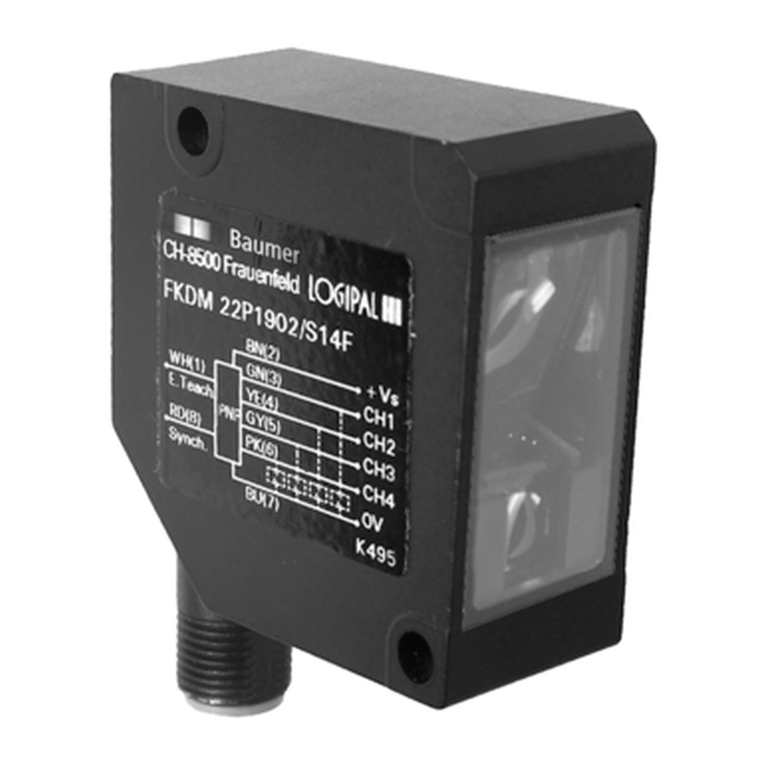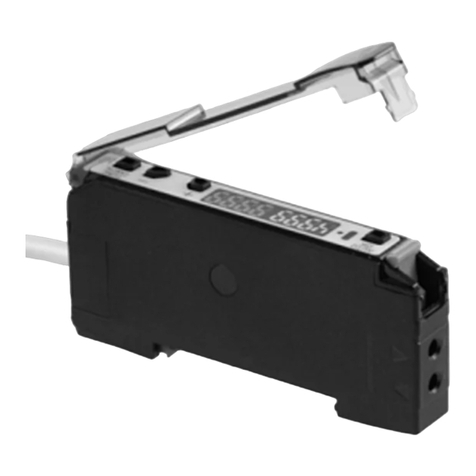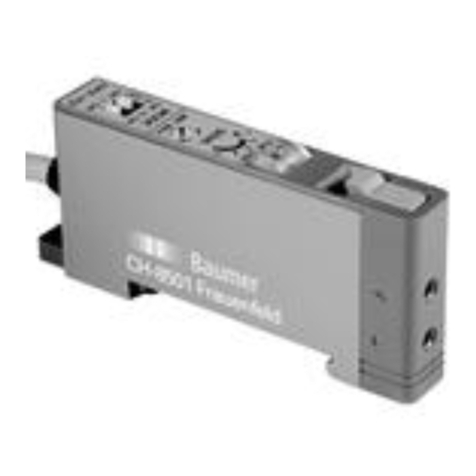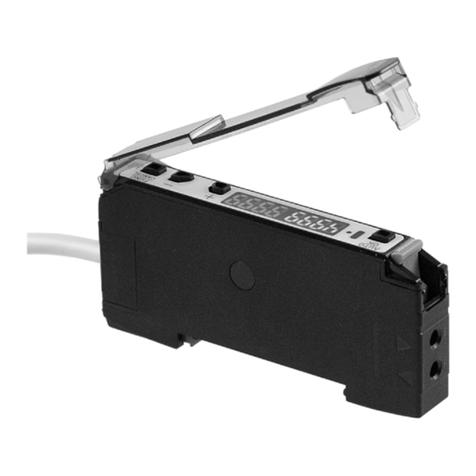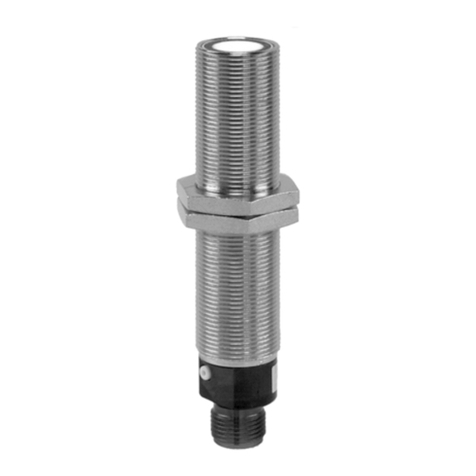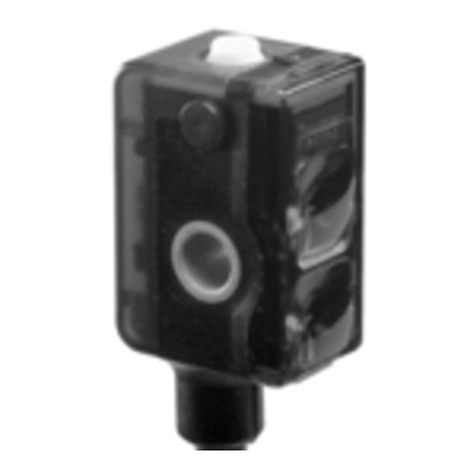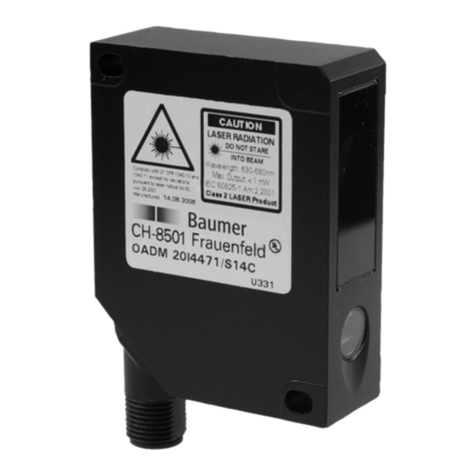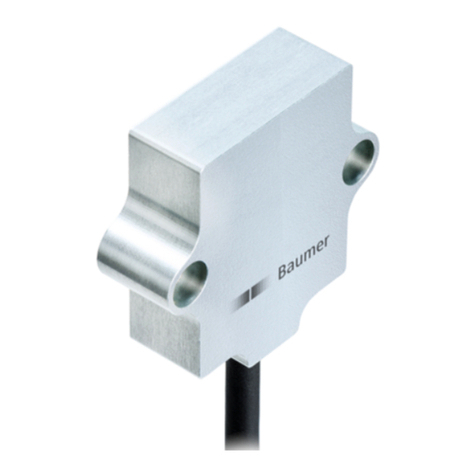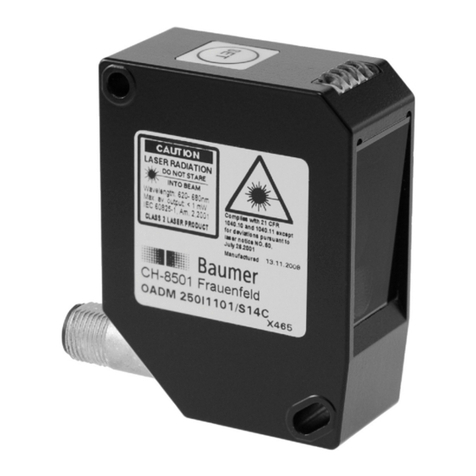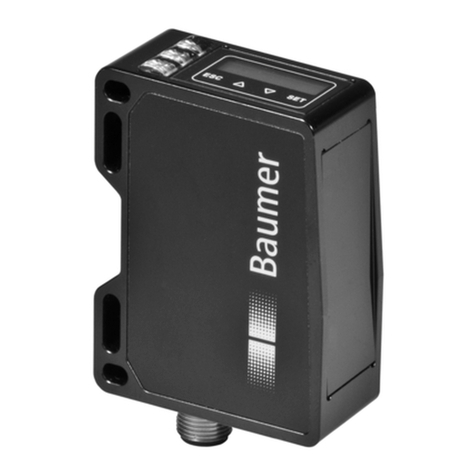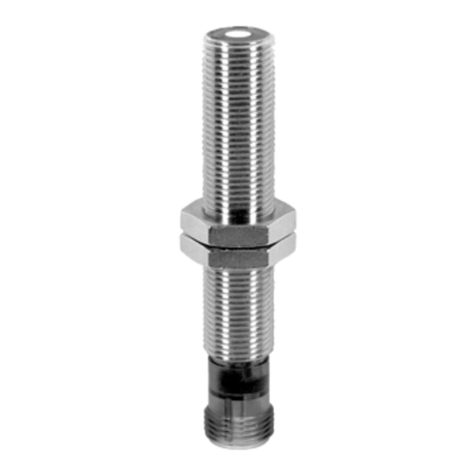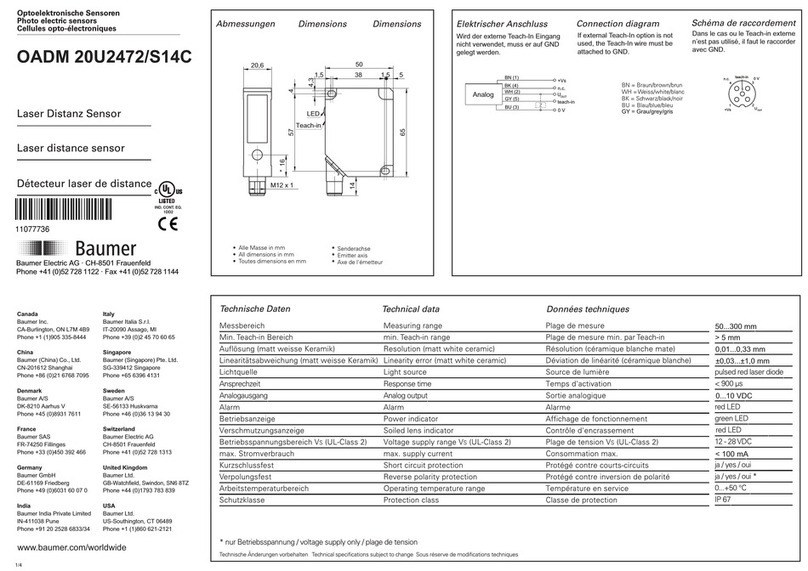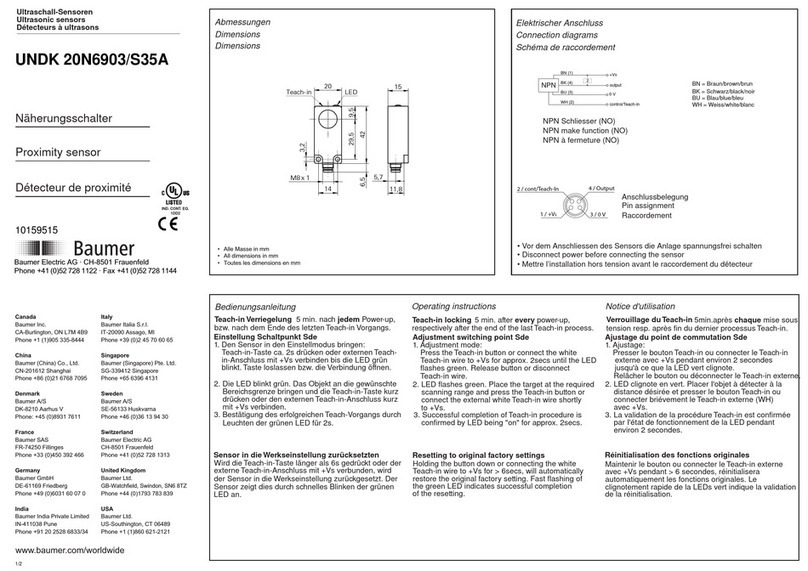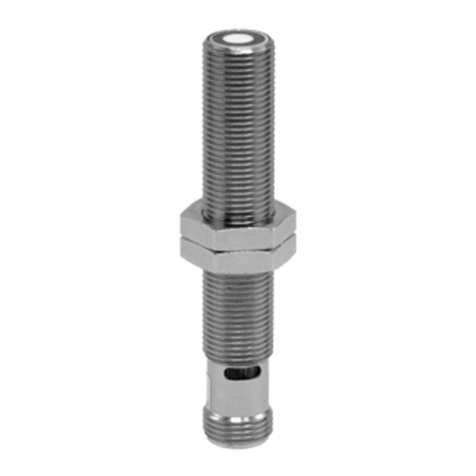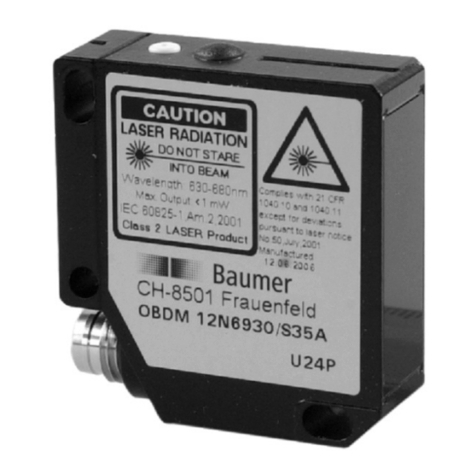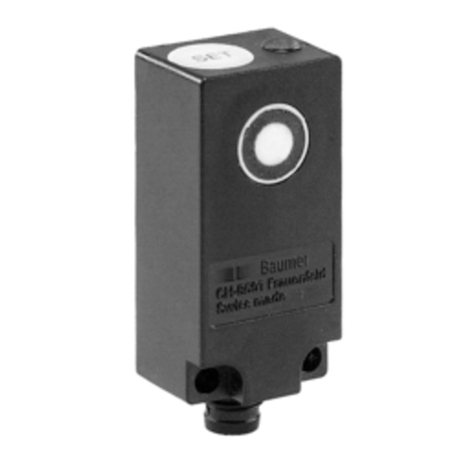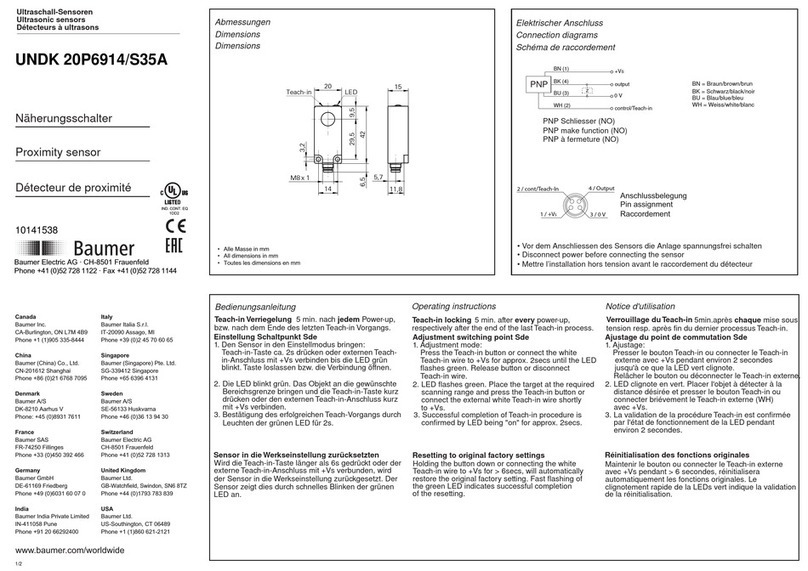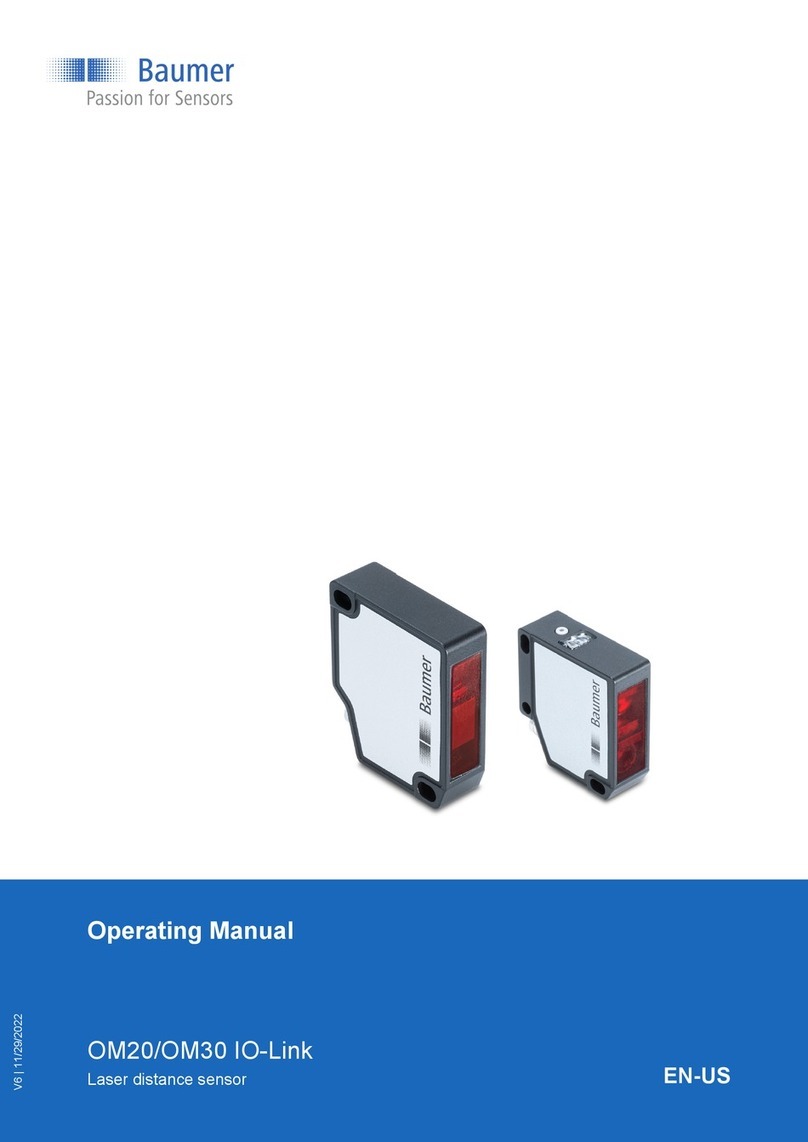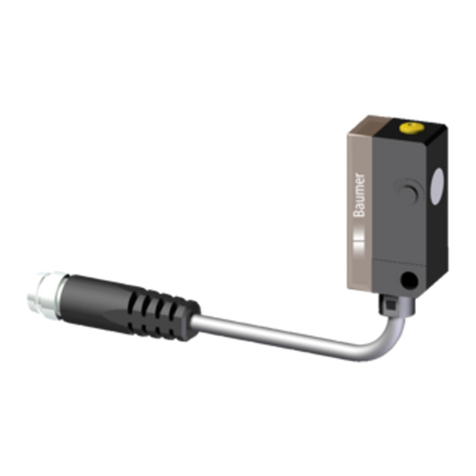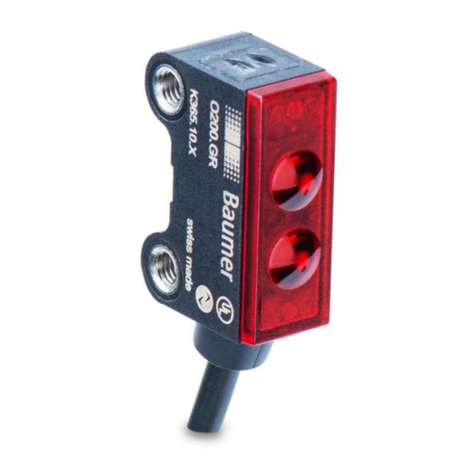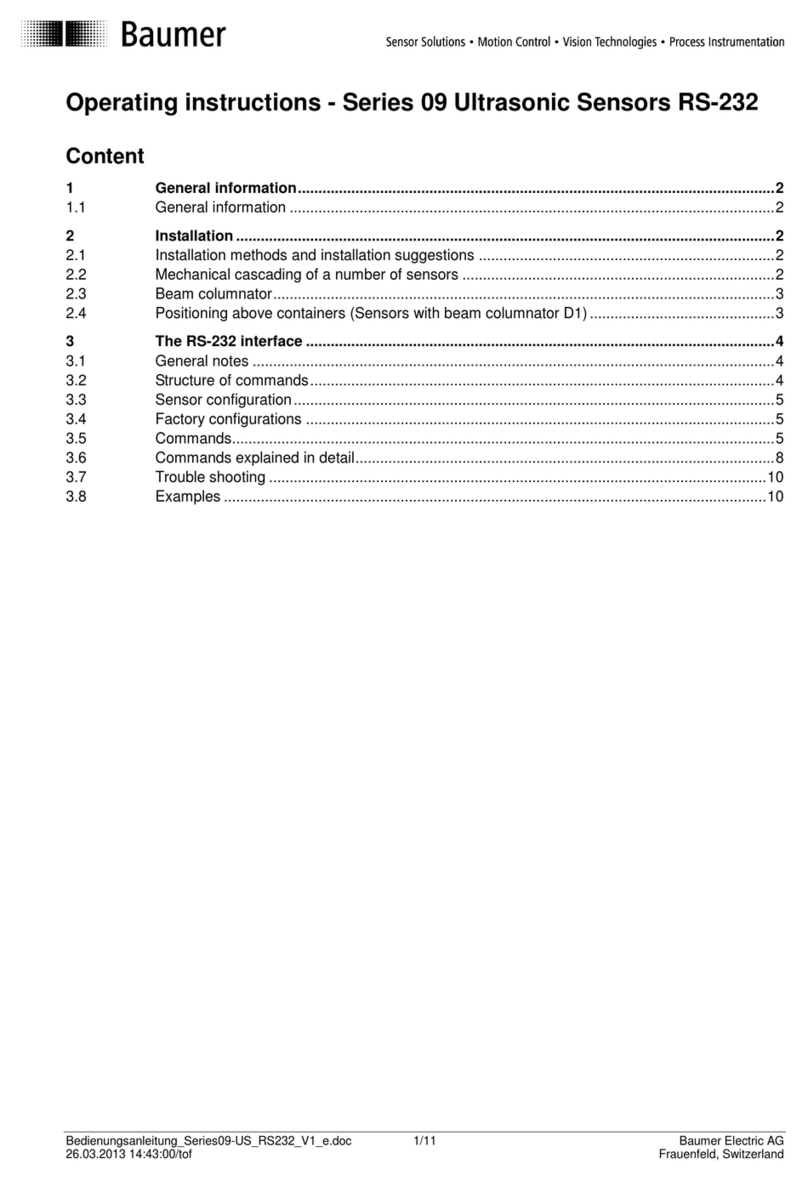OADM 12U6460/S35A
Messbereich teachen mit der Teach-Taste
Innerhalb von 5 Minuten nach dem Einschalten des Sensors lässt sich der Sensor
mit Hilfe der Taste teachen. Nach dem Teachen beginnen die 5 Minuten von neuem.
Nach 5 Minuten reagiert der Sensor nicht mehr auf die Taste.
1. Taste drücken; die rote LED geht an, wenn der Sensor noch teachbar ist.
2. Taste 5 Sekunden drücken, bis die rote LED zu blinken beginnt.
3. Taste loslassen.
4. Jetzt das Messobjekt auf die Grenze des Messbereichs setzen, bei
welcher der Sensor 0 V bzw. 4 mA ausgeben soll.
5. Taste kurz drücken; als Quittung leuchtet die rote LED für 3 Sekunden.
Danach blinkt sie gleichmässig weiter.
6. Jetzt das Messobjekt auf die Grenze des Messbereichs setzen, bei
welcher der Sensor 10 V bzw. 20 mA ausgeben soll.
7. Taste kurz drücken; als Quittung leuchtet die rote LED für 3 Sekunden.
Danach geht sie aus und blinkt noch einmal kurz auf. Der Sensor ist jetzt
wieder betriebsbereit.
Falls eine der beiden neuen Grenzen ausserhalb des max. Messbereichs war, oder die
beiden Grenzen zu dicht beieinander waren, dann wird anstelle der 2.Quittung für 5
Sekunden ein Blinken ausgegeben. Der Messbereich ist nicht geteacht. Er muss neu
geteacht werden, wobei der minimale Teachbereich und der Messbereich zu
berücksichtigen sind.
Fabrikzustand herstellen mit der Teach-Taste
Innerhalb von 5 Minuten nach dem Einschalten des Sensors lässt sich der Sensor mit Hilfe
der gelben Taste in den Fabrikzustand bringen. Nach jedem Teachen beginnen die 5 Minuten
von neuem. Nach 5 Minuten reagiert der Sensor nicht mehr auf die Taste.
1. Taste drücken; rote LED geht an, wenn der Sensor noch teachbar ist.
2. Taste 5 Sekunden drücken, bis die rote LED zu blinken beginnt. Taste NICHT loslassen.
Weitere 10 Sekunden gedrückt halten, bis die rote LED dauernd leuchtet. Damit
ist der Fabrikzustand (Standardmessbereich) wieder hergestellt. Die zuvor geteachte
Kennlinie wurde mit den Fabrikdaten überschrieben.
3. Taste loslassen
Wie funktioniert der Teach-in via Leitung?
Identisch Teach-Taste, indem die Teachleitung entsprechend mit
Vs+ verbunden wird. Im Gegensatz zur Teach-Taste wird die Teach-Leitung nach
5 Minuten nicht gesperrt und erlaubt so auch Veränderungen im laufenden Betrieb.
Teaching a new measuring range:
Within 5 minutes after power-up, the button may be used to teach a new range.
After finishing a teach procedure, the 5 minutes starts again. After the 5 minutes,
the sensor does not respond to pressing the button. Seven steps to teaching a
new measuring range:
1. Press (and hold) the button. The red LED will turn on, if the sensor can be taught.
2. Hold down the button for 5 more sec. The LED will start to blink.
3. Release the button.
4. Place a target at the first new position of the measuring range. This is the position
that will later produce 0 V (or 4 mA).
5. Briefly press the button again. The LED will stop blinking and will stay on for
about 3 sec to indicate that the first position has been stored. Then the LED will
blink again.
6. Now place the target at the second position (the other end of the new range),
which will produce 10 V (or 20 mA).
7. Briefly press the button again. The LED will stop blinking and will stay on for about
3 sec to indicate that the second position has been stored. The LED will then
turn off and blink once more. Now the sensor is ready to measure.
The new, smaller operating range is now set. The red LED now indicates whether
an object is within the new range (LED OFF) or not (LED ON). If one of the new
borders of the range was outside the standard range or the two positions were
too close to each other, then the new settings are not valid. The sensor will respond
with an extended blinking at the end of the teach procedure. The previous settings are
still valid and the new settings are lost.
How to reset the factory settings using the teach button
Within 5 minutes after power up, the button may be used to reset the sensor back to
the factory settings. After finishing a teach procedure, the 5 minutes starts again.
After the 5 minutes, the sensor does not respond to the button.
1. Push the button. The red LED will turn on, if the sensor can be taught.
2. Hold down the button further 5 sec. The LED will start to blink. DO NOT RELEASE
the button now. Wait another 10 sec until the LED is ON without blinking. Factory
settings have been restored to the sensor.
3. Release the button.
How does qTeach via wire work?
In the same manner as Teach in by button, by connecting the teach wire correspondingly
to Vs+. The programming wire is not locked after 5 minutes and so also allows changes
on the fly.
Apprentissage de la plage de mesure avec la touche Teach
Pendant une période de 5 minutes après l’enclenchement du détecteur, l’apprentissage peut se
faire au moyen de la touche jaune. Après l’opération d’apprentissage, une nouvelle période de
5 minutes recommence. Lorsque ces 5 minutes sont écoulées, le détecteur ne réagit plus aux
pressions de la touche.
1. Presser sur la touche; la LED rouge s’allume lorsque l’apprentissage du détecteur est
encore possible.
2. Presser sur la touche pendant 5 secondes jusqu’à ce que la LED rouge commence à clignoter.
3. Relâcher la touche.
4. Placer maintenant l’objet de mesure à la limite de la plage de mesure pour laquelle le
détecteur doit afficher une valeur de 0V respectivement 4 mA.
5. Presser brièvement sur la touche; la LED rouge s’allume pendant 3 secondes comme
confirmation. Ensuite, elle se remet à clignoter de façon régulière.
6. Maintenant, placer l’objet de mesure à la limite de la plage de mesure pour laquelle le
détecteur doit afficher une valeur de 10V respectivement 20 mA.
7. Presser brièvement sur la touche; la LED rouge s’allume pendant 3 secondes comme confirmation.
Ensuite, elle s’éteint pour clignoter encore une fois brièvement. Le détecteur est maintenant à
nouveau opérationnel.
La plage de mesure est maintenant réglée sur les nouvelles valeurs limites et la LED rouge
s’éteignent dès qu’un objet se trouve à l’intérieur de la nouvelle plage de mesure.
Dans le cas où l’une des deux nouvelles limites se trouvait à l’extérieur de la plage de mesure
maximum ou encore, si les deux limites avaient été choisies trop près l’une de l’autre, la LED
rouge se met à clignoter pendant 5 secondes à la place de la seconde confirmation. La plage de
mesure n’a pas été apprise. Il faut alors procéder à un nouvel apprentissage tout en respectant la
plage d’apprentissage minimale et la plage de mesure.
Réinstaurer l’état départ d’usine avec la touche Teach
Pendant 5 minutes après l’enclenchement du détecteur, celui-ci se laisse configurer comme au
départ de l’usine au moyen de la touche jaune. Après chaque processus d’apprentissage, une
nouvelle période de 5 minutes recommence. Lorsque ces 5 minutes sont écoulées, le détecteur
ne réagit plus aux pressions de la touche.
1. Presser sur la touche; la LED rouge s’allume lorsqu’un apprentissage du détecteur est encore
possible.
2. Presser sur la touche pendant 5 secondes jusqu’à ce que la LED rouge commence à clignoter.
Ne pas relâcher la touche. Maintenir la touche enfoncée pendant encore 10 secondes jusqu’à
ce que la LED reste constamment allumée. A la fin de cette procédure, l’état du détecteur au
départ de l’usine a été rétabli (plage de mesure standard). La courbe caractéristique précédemment
apprise a été remplacée par les valeurs d’usine.
3. Relâcher la touche.
Comment fonctionne le qTeach via la connexion?
Exactement comme avec la touche Teach, en raccordant la connexion
Teach à Vs+. Le fil de la programmation n'est pas verrouillé après 5 minutes et permet ainsi
également des modifications à la volée.
